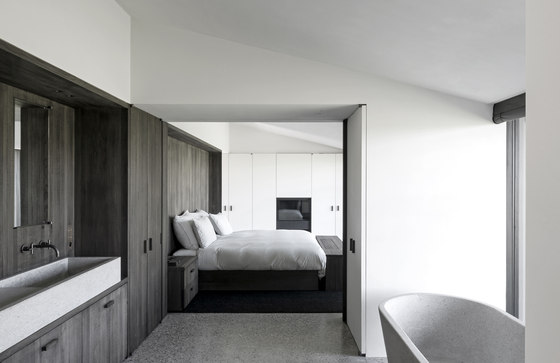On reclaimed land close to the sea, with views delineated by an urban coastline, a limited volume of trees, shrubs, and a centrally sited farm buildings define the organization of the domain. The assignment was to replace existing structures with a contemporary farming business, stables, and surrounding orchard. The project has created a central place in the open landscape with an outspoken identity of the ‘yard’ with three elongated black-slatted wooden volumes forming the heart and life of the farm. The house, horse stables, and barn creating a clear boarder around the courtyard, which remains only partially enclosed, permitting a connectedness to the surrounding meadows. On a smaller scale, the open and flat character of the courtyard, on one hand, is broken by an elongated water feature – centered between the house and stables – and on the other its flat character is broken by a 60-meter retaining wall that catches the small undulation in the topography and terminates in an integrated cesspit.
The basic volumes are of a utilitarian typology where function is reduced to a minimum and openings are limited to large sliding gates. The approach of the design and material is deeply considered and contributes to the contemporary character of the project. The design omits any ornament by the application of the façade materiality – gutters, drains, and ridgelines are abstracted to the point that they become almost invisible. Making reference to old wooden barns, the repetitive timber motif merges sills, eaves, and extends onto the roof whereas the farm house is granted larger openings for views to the landscape and courtyard and distinguishes itself from the other volumes by large chimney flues. From a distance the abstraction of the three wooden volumes is complete – the closer one gets to the project the more details become visible. The architecture is designed at the scale of furniture work. The abstract formal language of the façade is poetic in its refined detailing and, in the sunlight, the diaphanous rhythm of the slat work is further emphasized.
The initial brief was the creation of a house with in the typical company structure of a farm with a focus on silence and serenity. One asked for a structure with rural character and an appropriateness for function imbedded in its design. There is clear link between the house, the stables, the ring, and the landscape while taking into account the maximum 1000m3 control for new constructed farm houses. The initial concept proposed a discreet volumetric analysis of elongated and staggered structures to mark a clearly enclosed yard and inner area. The low long typology of farm buildings and barns is found nearby in the ‘polderboerderijen’ in Flanders as well as in The Netherlands. Because of the utilitarian nature of the brief – ‘this is a farm’ – one has chosen to make no distinction between home, stables, and barn. For the functional aspects of the brief, the classic eaved roof form of the farm building volume has been elongated the to create large utilitarian sheds.
The use of materials follows the barn typology but has been distilled. The storage rooms and stables of the farm are often covered in wooden planks both in Belgium and abroad. A natural and sustainable farmyard material that immediately references the rural character and forms the basis of the key construction material of the project. One has chosen, in a resolute way, to foresee all façade work, exterior cabinetry, and other visible parts in a black-stained wood, supported by a polished concrete base. This second sustainable material emphasizes again the utilitarian nature of the farm and is used a continuous floor surface both inside and out. Additional to this contemporary character, the black-stained wood contributes strongly to the sustainability and longevity of the built form. The palette of soft grey and anthracite is tempered by the surrounding in the green character of the trees, shrubs, and meadows. The green of the landscape also mingles with the exterior hard-scaped surfaces and defined planting that permeates the concrete strips in strategic places.
Vincent Van Duysen Architects















